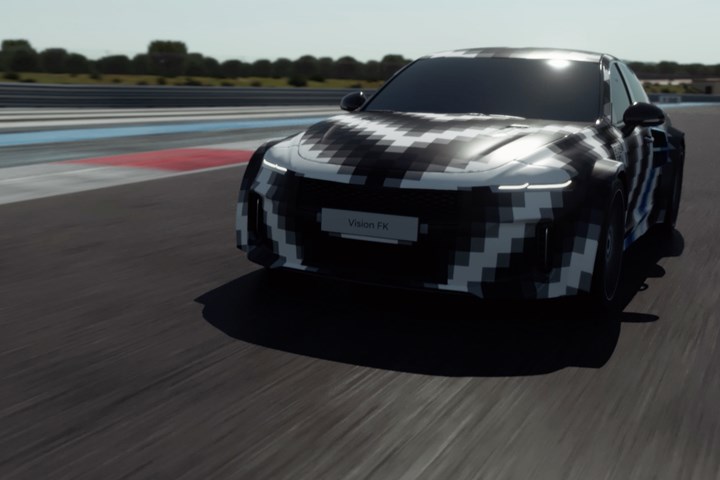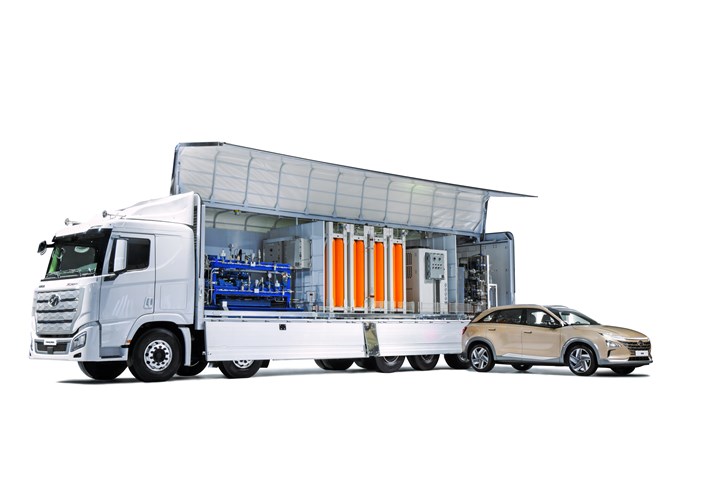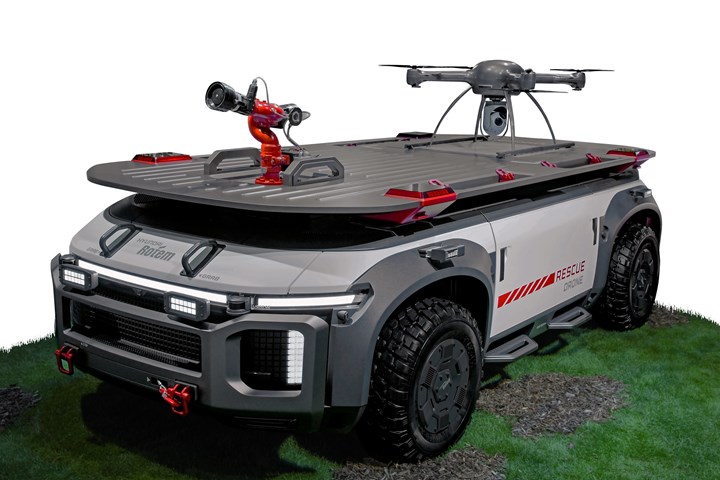Hyundai Motor Group plans to popularize hydrogen by 2040
Hyundai plans to convert all new commercial vehicle models — featuring fuel cell electric or battery electric powertrains, as well as the application of fuel cell systems — by 2028.

Photo Credit, all images: Hyundai Motor Group
Hyundai Motor Group (Seoul, South Korea) has set out its vision for hydrogen energy and a global hydrogen society.
At the Hydrogen Wave global online forum, the company presented its plans to popularize hydrogen by 2040 through the introduction of new technologies and mobility solutions in transportation and other industrial sectors.
Hyundai’s plans will see the electrification of all new commercial vehicle models — featuring fuel cell electric or battery electric powertrains, as well as the application of fuel cell systems — to all models by 2028. The company says it hopes to reshape the industry and realize a clean, sustainable future.
“Hyundai Motor Group’s vision is to apply hydrogen energy in all areas of life and industry, such as our homes, workplaces and factories. The goal is to make hydrogen readily used for everyone, everything and everywhere,” says Hyundai’s chairman, Chung Eui-sun, at the Hydrogen Wave forum. “We aim to help foster a worldwide hydrogen society by 2040.”
According to the Hydrogen Council (Brussels, Belgium), a global initiative of energy, transport, industry and investment companies, hydrogen energy will account for 18% of global energy demand by 2050, with a market size of $2.5 trillion. The group claims that the popularization of hydrogen energy will also help cut CO2 emissions by more than six billion tons a year, while creating more than 30 million new jobs.
Hydrogen Vision 2040: Carbon neutrality solution via an energy paradigm shift
Hyundai plans to proactively respond to climate change through hydrogen solutions starting with the commercial vehicle sector, which emits larger amounts of CO2 and requires longer drive ranges compared to the passenger vehicle sector. As a result of such findings, the company will launch new commercial vehicles such as buses and heavy-duty trucks for the global market as fuel cell electric vehicles (FCEVs) and battery electric vehicles (BEVs). By 2028, the company expects to become the first global automaker to apply its fuel cell system to all commercial vehicle models.
Hyundai has already started mass-producing an improved version of the current Xcient Fuel Cell, the fuel cell heavy-duty truck. It is also developing a tractor based on the Xcient Fuel Cell that will be released in 2023. During Hydrogen Wave, the company also unveiled the Trailer Drone concept, a hydrogen-powered container transportation system capable of operating fully autonomously, with a double e-Bogie configuration.

In addition, Hyundai plans to re-energize global commercial vehicle markets including Europe — which at present consists of 400,000 new units a year — through its next-generation fuel cell technologies. The company will develop a five- to seven-meter fuel cell purpose built vehicle (PBV) to target the global light commercial vehicle market projected for seven million unit sales per year by 2030. This will be in part undertaken by an expansion in its business capabilities and applying autonomous driving and robotics to the commercial vehicle sector.
Fuel cell systems are not only being used commercially for vehicles such as the Nexo SUV, Elec City Bus and Xcient Fuel Cell truck, but also have the potential for deployment across diverse applications by 2040, including high-performance vehicles, urban air mobility (UAM), robots, aircrafts and large ships. As a result of such capabilities, Hyundai plans to expand the scope of fuel cell systems and technologies to all areas of the energy sector, including the provision of electricity and heating to buildings, urban energy sources and power plants.
To achieve this, Hyundai is planning to introduce a new generation fuel cell system in 2023 that comes with a reduced price and volume, as well as significantly improved durability and output. Through ongoing R&D, engineering teams for the company have reportedly been able to reduce fuel cell costs drastically over the last 20 years. Hyundai says its goal is to achieve a fuel cell vehicle price point comparable to a battery electric vehicle by 2030.
Next-generation fuel cell systems
It’s been an ongoing process for many years for the company to strive to reduce the cost of fuel cell systems for mass application. In this process of continuous improvement, Hyundai has made great leaps in R&D and is presenting the results for the world to see.
During Hydrogen Wave, the Group presented a series of new fuel cell systems including a new prototype of its third-generation fuel cell stack — a higher-powered, efficiently packaged successor to the Nexo system — that is planned for market introduction in 2023.
Hyundai showcased two power versions of its third-generation fuel cell stack, which are currently in development: 100 kilowatts (kW) and 200 kW. The 100-kW stack reportedly has reduced in size by 30%, making it easier to apply to different vehicle types and applications. The 200-kW version has been designed for commercial vehicle applications and is similar in size to the current Nexo system, but the power output has doubled.
For the third-generation fuel cell development, the company's goal is to improve durability by 50-100%. According to Hyundai, high durability stacks for commercial vehicles can achieve 500,000 kilometers of drive range. The company also plans to offer the third-generation fuel cell stack at a dramatically reduced price — with projections being upwards of 50% — which will be the key factor to achieving cost parity of FCEVs with BEVs by 2030.
Hyundai says the third-generation system also features a new Power Unit Module, which can offer a range of outputs from 500 kW to one MW by stacking 100-kW modular units, making it usable as an emergency power system for large ships or IT companies. It will also feature the Full-Flat System, which lowers stack height to 25 centimeters, allowing the system to be used for various applications such as PBVs, MPVs, buses and trams by mounting the system to either the upper or lower body of the vehicle.
The future for hydrogen mobility
At Hydrogen Wave, Hyundai presented its vision for future hydrogen mobility across several vehicle applications, from emergency relief and rescue, through autonomous container transportation and high-performance sports cars.
Production, storage and transportation convenience will be important factors for the widespread application and the use of fuel cell technology. Under Hyundai’s HTWO brand for fuel cells, the company is unveiling new concepts for portable, hydrogen refueling facilities.
Trailer Drone

The Trailer Drone concept is a hydrogen-powered container transportation system capable of operating fully autonomously. With packaged hydrogen tanks tailored to the journey profile, the Trailer Drone reportedly ensures more than 1,000 kilometers of sufficient range from a single charge, comparable to existing container transportation systems.
The autonomous capabilities of the Trailer Drone were not achieved by simply repurposing technology developed for passenger car applications. The unique requirements of container transport applications and the way container terminals operate meant that Hyundai’s engineering teams needed to completely redefine how a container maneuvers. As a result, the engineering team developed the Fuel Cell e-Bogie.
Fuel Cell e-Bogie
According to Hyundai, the term ‘bogie’ originates from the rail industry. Rail bogies are wheel subframes that sit under every train car. The Fuel Cell e-Bogie sits under the container like a rail bogie and is a fully enclosed system with fuel cell propulsion and fully independent four-wheel steering. The Trailer Drone concept requires two fuel cell e-Bogies, allowing for maneuverability through sideways movement. The Trailer Drone can reportedly move autonomously through portside operations and tight urban environments. Cluster Mode enables multiple Trailer Drones to travel together in an almost train-like configuration.
Hyundai says the Fuel Cell e-Bogie is not exclusive to the Trailer Drone and caters to a wide value chain, such as ground logistics, construction, firefighting and disaster relief missions. It offers a multi-purpose platform, capable of a variety of objectives — all in zero-emission and autonomous operation.
Vision FK
Fuel cell technology is also applicable to high-performance vehicle applications. Hyundai has showcased a concept hydrogen-powered hybrid sports car, named the Vision FK. With a maximum output of more than 500 kW, the Vision FK concept can reportedly accelerate from 0-100 kilometers/hour in less than four seconds. Combining a fuel cell energy converter with a high-power, rear-wheel drive, plug-in powertrain, the Vision FK aims to achieve more than 600 kilometers in range.
Drone
The Drone is a new concept mobility solution that combines with a Fuel Cell e-Bogie to create a flying drone that can be operated remotely and autonomously for critical operations such as fire-fighting and life-saving. The Rescue Drone features an independent steering system for in-place turning maneuvers and “crab-walk” driving. It can also carry out missions via images transmitted from drones mounted on the vehicle exterior and reportedly achieves a 450-500-kilometer driving range from a single charge.

H Moving Station
The H Moving Station is a heavy-duty vehicle equipped with charging facilities for FCEVs. According to Hyundai, this portable hydrogen refueling station ensures convenience as well as charging options in areas with limited hydrogen refueling stations.
Rescue Hydrogen Generator Vehicle (RHGV)
The RHGV supplies power to vehicles in need of urgent assistance in remote, off-road areas. The portable electric vehicle charger reportedly offers single-phase 220 volts and three-phase 380 volts simultaneous power supply.
The table below outlines all mobility and fuel cell systems presented at the Hydrogen Wave forum:
| Name |
Specification (Length × Width × Height) |
Key Features |
|
M. Vision POP |
2,600 × 1,644 × 1540 mm |
|
|
M. Vision 2GO |
3,200 × 1,644 × 1,600 mm |
|
|
Nexo Minicar |
1,180 × 700 × 550 mm |
|
|
Xcient Fuel Cell |
9,745 × 2,550 × 3,730 mm |
|
|
Fuel Cell Electric Team |
8,701 × 2,585 × 4,060 mm |
|
|
Mobile Fuel Generator |
2,850 × 1,550 × 1,225 mm |
|
|
Hydrogen Fuel Cell Powerpacks |
[30kW] 680 × 820 × 620 mm [50kW] 852 × 1025 × 784 mm |
|
Related Content
Why aren't composites synonymous with infrastructure?
The U.S. seems poised to invest heavily in infrastructure. Can the composites industry rise to the occasion?
Read MoreMaterials & Processes: Composites fibers and resins
Compared to legacy materials like steel, aluminum, iron and titanium, composites are still coming of age, and only just now are being better understood by design and manufacturing engineers. However, composites’ physical properties — combined with unbeatable light weight — make them undeniably attractive.
Read MoreThe state of recycled carbon fiber
As the need for carbon fiber rises, can recycling fill the gap?
Read MoreCarbon fiber in pressure vessels for hydrogen
The emerging H2 economy drives tank development for aircraft, ships and gas transport.
Read MoreRead Next
Composites end markets: Energy (2024)
Composites are used widely in oil/gas, wind and other renewable energy applications. Despite market challenges, growth potential and innovation for composites continue.
Read MoreFrom the CW Archives: The tale of the thermoplastic cryotank
In 2006, guest columnist Bob Hartunian related the story of his efforts two decades prior, while at McDonnell Douglas, to develop a thermoplastic composite crytank for hydrogen storage. He learned a lot of lessons.
Read MoreCW’s 2024 Top Shops survey offers new approach to benchmarking
Respondents that complete the survey by April 30, 2024, have the chance to be recognized as an honoree.
Read More
















.jpg;maxWidth=300;quality=90)











